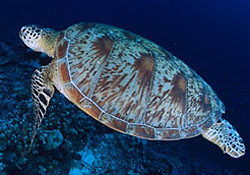|
Ocean Trivia
1. What is bioluminescence?
Fireflies sparking on a summer's evening; jellyfish glowing in
night waters. These are examples of bioluminescence: light produced
by living plants and animals from a biochemical reaction to oxygen.
The majority of bioluminescent marine creatures are planktonic
organisms found in huge groups that will glow in the wake of swimming
fish or passing ships. Phosphorescent Bay in Puerto Rico has an
extremely heavy concentration of these bioluminescent organisms.
Bioluminescence was once confused with phosphorescence because
it was believed the light was caused by the element phosphorus.
2. How many different species of ocean fish exist?
The total number of species of ocean fish ranges from 15,000 to
40,000 with the figure of 25,000 most often cited. There are several
reasons for the discrepancy. Some fish species have not yet been
named while others are often named more than once because of inadequate
descriptions and variations in geographical distribution.
3. Where are the majority of fish in the ocean located?
The largest numbers of fish are located in the Southern Hemisphere
due to the fact that these waters are not largely exploited by
humans.
4. What is the largest animal on Earth?
The blue whale is the largest known animal to live on sea or land.
Individuals can reach more that 110 feet in length and weigh nearly
200 tons which is equivalent to 50 adult elephants. The blue whale's
blood vessels are so wide that a full-grown trout could swim through
them. These vessels serve a heart the size of a small car.
5. What is the longest bony fish?
The oarfish is the longest bony fish in the world. With its snake-like
body sporting a magnificent red fin along its 50-foot length,
horse-like face, and blue gills, it accounts for many sea-serpent
sightings.
6. What is the largest bony fish?
The bluefin tuna are the largest bony fish. An adult may weigh
up to 1,500 pounds. Prized for sushi in Japan, bluefins can bring
as much as $20,000 each at US docks.
7. What is the fastest marine fish?
The bluefin tuna is among the fastest marine fish to live in the
oceans. An adult can swim up to 55 miles per hour.
8. Can coral be used to replace human bone?
Since the architecture and chemistry of coral are very close to
human bone, coral has been used to replace bone grafts in helping
human bone to heal quickly and cleanly.
9. Can life exist without sunlight?
Hydrothermal vents, fractures in the sea floor that spew sulfur
compounds, support the only complex ecosystem known to live on
chemicals rather than energy from the sun. Gigantic tubeworms
and mussels thrive in ocean pressures of up to 65 pounds per square
inch around these vents.
10. What is the amount of electricity from an electric eel?
The electric eel (which isn't a "true eel") discharges 350 volts
on average and up to 650 volts total. However, brief discharges
of 500 volts at 2 amperes have been measured, which produced 100
watts of energy. Voltage continues to increase in eels up to 3
feet in length, after which as their length increases only the
amperage increases. Electric eels in South America can reach lengths
of up to 10 feet. In addition, there are at least 500 kinds of
fish that produce noticeable amounts of electricity.
--Courtesy of Neptune's Web, the Naval Meteorology and Oceanography Command (CNMOC)
Sea Turtles
Green turtles are found throughout the tropics, usually near continental coasts and around islands, though they have also been seen in cooler temperate waters. They are named for the color of their cartilage and fat
deposits around their internal organs. If you were to see one, it
would look dark black-brown or greenish-yellow. The shell is oval
when viewed from above and the head is relatively small and blunt.
 |
Green turtle - Indo Pacific Ocean
photo: WWF-Canon / Jürgen FREUND
|
Green turtles are the only herbivorous marine turtle. They mainly
eat sea grasses, which are flowering plants in shallow coastal
waters. Females migrate huge distances between their feeding grounds
and nesting beaches. Individual females nest about once every
three years and lay between two to five clutches of 40 to 200
eggs.
An estimated 100,000 green turtles are killed around the Indo-Australian
archipelago each year. Survival rates are higher for the species
in the Atlantic versus the Pacific. Recovery has occurred under
strong conservation management regimes, but only in a very few
cases (e.g., Florida in the United States and Sabah Turtle Islands
National Park in Malaysia). The species is endangered, which means
it is in danger of becoming extinct.
|
![]()